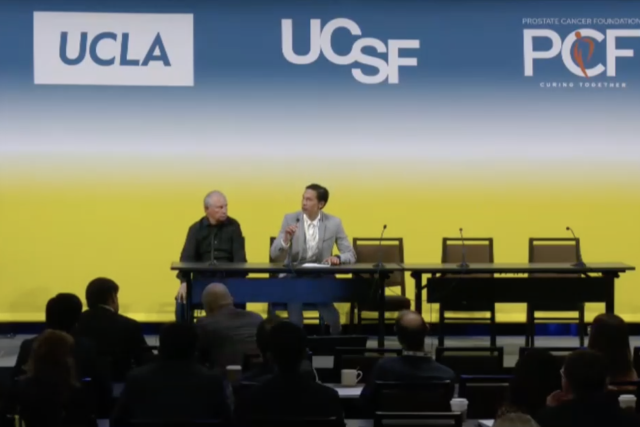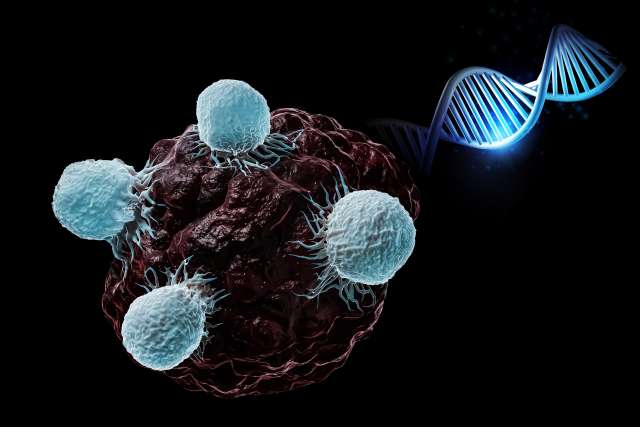Kent Greer, who was diagnosed with prostate cancer in 2014, learned in 2022 that his disease had metastasized. After a draining and difficult-to-tolerate round of chemotherapy, his oncologist in Bakersfield referred him to the Outpatient Theranostics Center at UCLA Health.
There, he learned he was a candidate for Lutetium-177 vipivotide tetraxetan (Pluvicto) – a radionuclide therapy that delivers targeted radiation to cancer cells while sparing healthy tissue. It is intended for patients with prostate-specific membrane antigen (PSMA)-positive metastatic prostate cancer (mCRPC) who have undergone surgery and were treated with androgen receptor pathway inhibitor (ARPI) therapy.
The patient told his story to an audience at the 2025 PSMA & Beyond Conference during a session moderated by Jeremie Calais, MD, PhD, director of the Ahmanson Translational Theranostics Division’s clinical research program and a member of the UCLA Health Jonsson Comprehensive Cancer Center.
The conference – co-hosted by UCLA, UCSF and the Prostate Cancer Foundation – brought together global leaders in PSMA PET imaging and radioligand therapies to highlight the present and future of prostate cancer care.
“I wish I could have bypassed chemotherapy, which really beat me up and made me susceptible to other diseases, like COVID-19. With Pluvicto, I’ve had nearly no side effects,” Greer said.
Treating PSMA-positive prostate cancer
UCLA Health was among the first U.S. sites to participate in a phase II clinical trial evaluating the safety and efficacy of Pluvicto. The therapy was subsequently licensed by Novartis and approved by the Food and Drug Administration for use in adults with advanced metastatic prostate cancer unresponsive to other treatments.
Theranostics agents such as Pluvicto deliver targeted radiation to cancer cells while sparing healthy tissue. The process begins with the administration of a companion radiotracer — a diagnostic agent with low-level radiation — that binds to specific antigens on cancer cells. This enables clinicians to precisely visualize tumors and antigen expression via positron emission tomography (PET).
Based on these findings, patients then receive the therapeutic component of the therapy, which targets the same antigen and delivers cytotoxic radiation directly to the cancer cells, inducing DNA damage and cell death.
Mr. Greer said that the day after his post-chemotherapy scan in 2023, he was entered into the UCLA Health system and quickly scheduled to receive the Pluvicto treatment. “The UCLA staff has been fantastic,” he said.
After receiving his first round of Pluvicto, Mr. Greer has enrolled in a phase II trial to test how well he responds to a second round of treatment. Initial studies have shown that re-treatment with Pluvicto in patients who had an initial favorable response may improve survival outcomes and disease response.
In March 2025, the FDA expanded the indication for Pluvicto for earlier use in PSMA-positive prostate cancer patients. These patients no longer must receive chemotherapy to qualify for the treatment.
“I wanted to be here today to pave the way for other guys like me,” Mr. Greer said. “I want to be an advocate to go straight to Pluvicto and bypass chemotherapy, so I’m glad to see that that’s happening now.”
Radiation Safety and Ecology
At UCLA Health, patients receiving Pluvicto are treated at the Outpatient Theranostics Center, one of the largest clinics of its kind in the United States. The 3,000-square-foot facility in Westwood, which opened in February 2024, is particularly designed to keep both patients and staff protected from the potential toxic side effects of radioactive therapy.
Catherine Meyer, PhD, an assistant professor in UCLA’s Department of Molecular and Medical Pharmacology, highlighted the comparison of radiation safety practices across the United States and world during her presentation at the PSMA & Beyond Conference.
Agencies such as the International Atomic Energy Agency (IAEA) and the U.S. Nuclear Regulatory Commission (NRC) regulate nuclear materials and exposure limits, Dr. Meyer explained.
To operate, a theranostics facility must meet the infrastructural shielding requirements for handling radioactive material and patients. At UCLA Health, this includes radiation shielding for syringes and vials, portable shielding where needed, as well as lead-lined walls and barriers inside the clinic.
“You have to know who will be in which room and for how long, you have to know how many patients you’ll be treating, and you have to future-proof the numbers to ensure you’re building in sufficient shielding,” Dr. Meyer said.
There is no standardization across countries for the discharge of patients who have received radioactive therapy. While countries like Germany require in-patient hospitalization for up to 48 hours post-treatment, the United States allows outpatient administration.
Following their treatment, patients who undergo radionuclide therapy in the U.S. may be asked to stay isolated or keep their distance from other people for a certain number of days. The duration of their isolation and other safety practices depends on the type and dosage of their specific treatment, as well as other individual factors.
“To the outside observer, it may seem like a very simple infusion set-up at UCLA’s Theranostics Center,” Dr. Meyer said, “but of course there is much more than meets the eye.”




